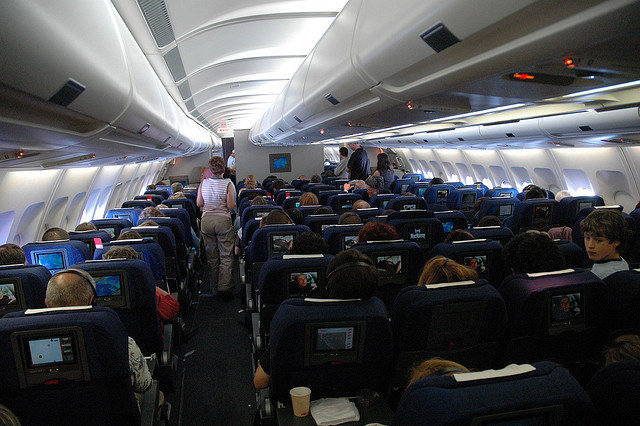Planes and airports can be tough on your body in more ways than one, but with a little pre-planning you can sidestep the worst of it and stay healthy when you fly.
Pat-downs vs. scanners
Every so often the topic of overexposure to radiation courtesy of airport scanners will come up, especially concerning frequent flyers. According to a recent study commissioned by the American Association of Physicists in Medicine (AAPM), though, unless you’re scanned over 22,500 times a year (the standard maximum safe yearly dose determined by the American National Standards Institute and the Health Physics Society), you’re good to go. Still concerned? Ask for a pat-down instead.
The shoeless shuffle
You know the drill: shoes in the bin. Which means millions of shoeless feet—along with their germs and bacteria—will be shuffling down the same strip of floor you are. The alternative? Wear socks. And if you’re wearing sandals and don’t like the “grandpa look,” just have a pair in your bag and pop them on just for the inspection. Consider the alternative (yeah, it’s that gross).
Dress to impress (yourself)
Skinny jeans are all the rage, but they’re not the best thing to wear on long flights (or anything tight for that matter). Opt for layers so you can navigate the changing temps and give your body room to relax. Avoid tight socks even on short flights (wear compression socks on extra long flights) and think comfort over style. Tuck slippers or flip flops into your carry-on— you won’t want to walk to the bathroom in just your socks.
Bring anti-bacterial wipes and sanitizer
Whatever you touch in an airport or on a plane has been touched and re-touched by millions before you—and you know not everyone washes their hands on a regular basis. Your best defense is to be liberal with the sanitizer, the wipes, and washing your own hands, plus avoid touching your mouth or eyes during the trip. When you board the plane, never mind the stares and wipe down the tray table (true story: clipping nails is a common inflight activity), the seatbelt buckle and the armrests. Oh, and studiously avoid the seat pocket in front of you and everything that’s in it. If you must use it, line it with the plastic bag you got with your magazine at the newsstand. Weird stuff gets scrunched down in there.
Hydration Part 1
Planes have complicated HEPA filtering systems to keep germs and viruses at bay, but it’s still dry as the Sahara up there and that can wreak havoc on your system (as can your hacking seatmate). Avoid airplane colds as best you can by keeping your defenses up: stay hydrated during the flight by sipping water throughout and give your nose a helpful hand with a nasal mist. Hot drinks (tea over coffee) will also help keep your mucous membranes in working order.
Hydration Part 2
Opt for salad, fruit or other water-rich foods over they typical salty snacks—your ankles will thank you. Avoiding sodas, alcohol and caffeine prior to and during your flight is also a good idea, and be sure to sip at least 8 ounces of water per hour of flight time. Bring a small tube of lotion to apply to your hands, face and feet to keep your skin hydrated as well.
Carry-on your comfort
Some airlines go the extra mile and supply headphones, blankets and pillows, but unless they have been scrupulously sanitized or are fresh from the factory, consider them off limits and bring your own.
Move it
Long periods of immobility are not only uncomfortable, but can also be hazardous to your health. Combined with dehydration and low cabin pressure, this can actually set the stage for developing leg clots. There’s no need to sprint down the aisles every hour: simply contracting your calf muscles or tapping your feet is enough to get the venous blood pumping in your lower extremities.
Want to take along more peace of mind during your travels? Don’t forget to sign up for a SkyMed membership!
Photo credit: caribb via photopin cc








